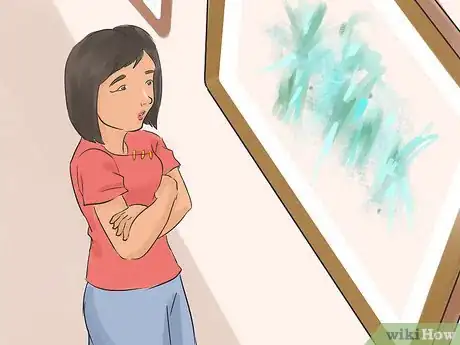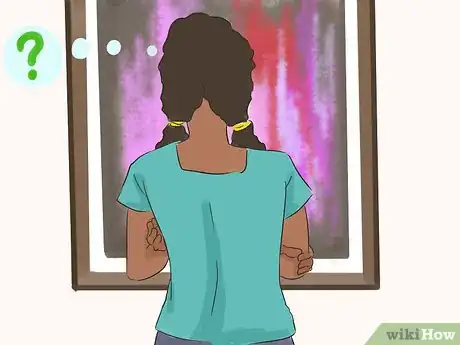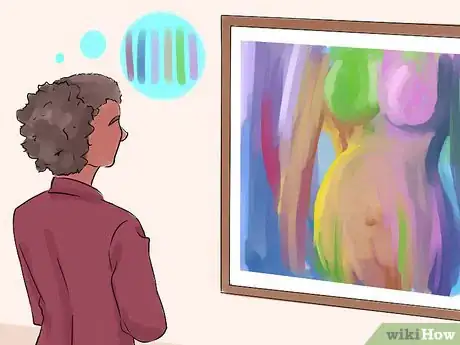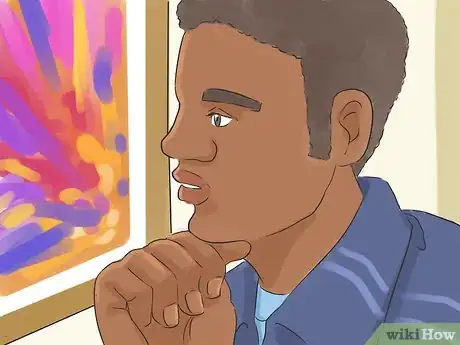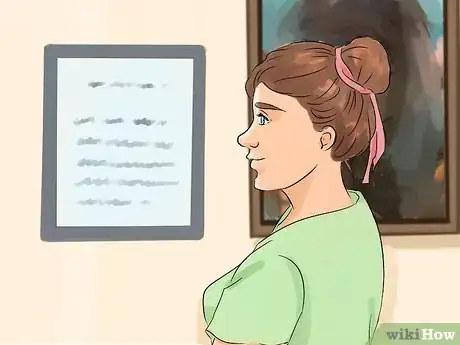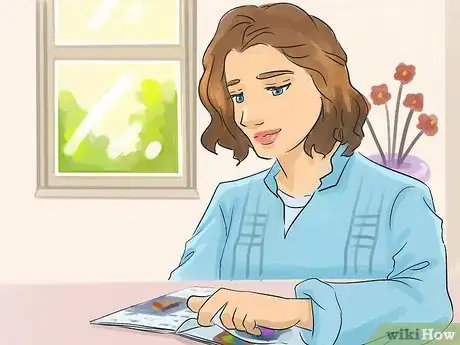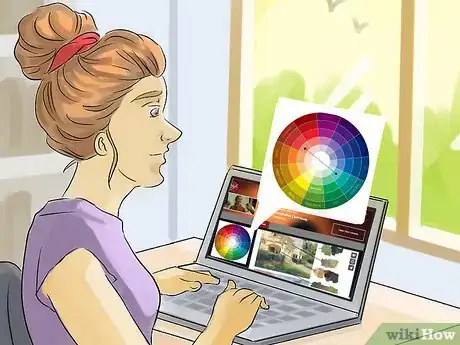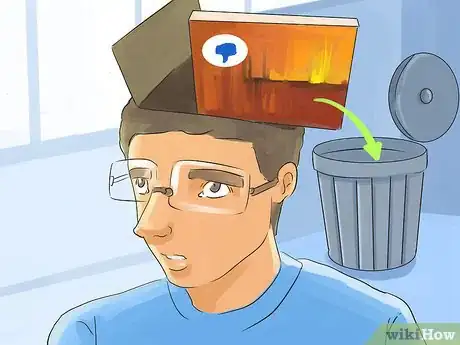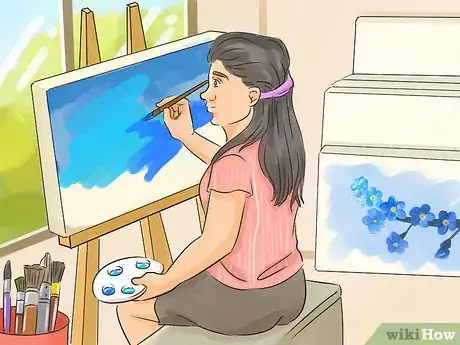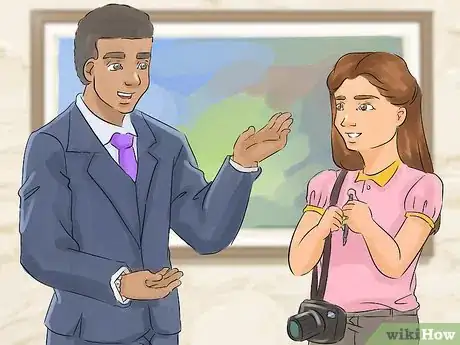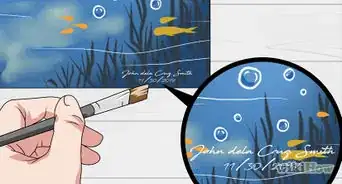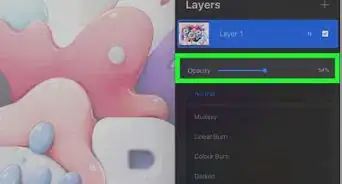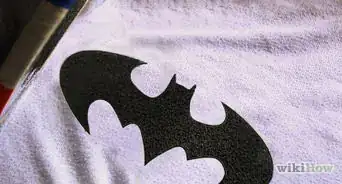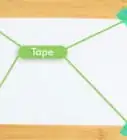This article was co-authored by Rebecca Schweiger. Rebecca Schweiger is a Professional Artist, Published Author, and the Founder of The Art Studio NY, New York City's #1-rated art school and global online art studio. Celebrated by TV networks, press, and celebrities including NBC, ABC, E!, Time Out New York, The Kardashians, and Big Bang Theory's Jim Parsons, Rebecca specializes in creating abstract artwork and teaching studio art classes. Her art studios provide 100+ weekly, beginner-friendly drawing and painting art classes to people around the globe. With more than 22 years of art experience, she is the author of Release Your Creativity: Discover Your Inner Artist with 15 Simple Painting Projects, and her artwork has been exhibited in more than 50 museums and galleries around the world. Rebecca holds a BFA in Painting from Boston University's School for the Arts and has participated in acclaimed artist residencies worldwide.
There are 10 references cited in this article, which can be found at the bottom of the page.
This article has been viewed 163,477 times.
Understanding and appreciating abstract art can be tough if you don't have much experience with art. In order to gain an appreciation for abstract artwork, you'll have to look at it in a different way and understand the history and reasons it was created.[1] Once you learn more about the craft and those creating it, it's likely that you'll gain a whole new appreciation for the style of artwork.
Steps
Looking at Abstract Art
-
1Relax as you look at abstract art. Being distracted or stressed can actually affect how you enjoy art. It’s best to go to the gallery or view the art when you’re in a relaxed state so that the art affects you in a positive way. Limit distractions around you, like your cell phone, and try to clear your mind of negative or stressful thoughts.[2]
- If you want to block out the sounds of other people in the gallery or museum, put earplugs in your ears.
- To relax, you can meditate, practice breathing exercises, or listen to calming music.
-
2Look at the artwork as objectively as you can.[3] Avoid saying things like “Anyone could make that” and dismiss prior notions or opinions you have about the artwork before you actually see it. Try to approach the art with an open mind and don't compare it to other work, especially if it's not in the same style.[4]Advertisement
-
3Ask yourself how the painting makes you feel. Instead of trying to evaluate the technical aspects of the art, ask yourself how the art makes you feel.[5] If it makes you feel happy, sad, anxious, excited, or calm, it's a sign that it had an emotional impact on you. Be honest with yourself to determine how you really feel.[6]
- Sometimes abstract art is more about the feeling and less about the brush strokes. Take this into consideration when looking at abstract art.
-
4Note the basics of composition. Even if the subject matter is abstract, the composition of a piece of artwork can elicit an emotional response. Look at how the painting takes up the canvas. Does it feel balanced or in disarray? Even if the objects within the piece of artwork seem random, the composition of the painting could be purposeful and meaningful.[7]
- For example, a simple shape on a blank canvas can elicit a calming response, while different colors splattered on a canvas could elicit a frantic or anxious feeling.
- You can research the basics of art composition online.
-
5Take a closer look at the painting. Move closer to the painting and examine the strokes and color up close. Take notice of how well the colors blend and the stroke consistency. Recognize the different techniques that the artist used and consider what it took to create it.[8]
- When you get closer to art, you can really evaluate its textures and colors.
- Never touch pieces of artwork.
- Research popular abstract art techniques online to develop your appreciation.
-
6Take a step back and evaluate what you've seen. After you've looked at all aspects of the abstract artwork, take a step back and reflect on how you feel about the art. If you feel like they conveyed their emotions well or composed the art well, you should have an elevated feeling of appreciation for what they created.[9]
- An elevated emotional response may also mean that the art got through to you!
Researching to Develop Your Appreciation
-
1Read the informational plaque next to the artwork. Some galleries have an informational plaque near the artwork that describes the artist. If you don't have time to research them, this is a great way to better understand the artist and their mindset when they created the art.
- For example, if the artist witnessed the atrocities of war, a dark, depressing, or violent feeling may be conveyed through their abstract art.
-
2Research the artist’s life. Understanding the reason that the artist created the piece of art will give you a deeper appreciation for the art and the artist. Most abstract art tries to capture a feeling or emotion like sadness, rage, or happiness. The artist's life might interest you enough for you to develop an appreciation for their abstract art.[10]
- For example, The Scream by Edvard Munch was based on a scary experience that he had in real life.[11]
- You can usually find information about artists online.
-
3Look at the artist’s other artwork. If you don’t like the abstract art that an artist created, take a look at their other work. You may like their other styles of artwork enough to form an appreciation for their abstract works. You can typically find examples of their other artwork online.[12]
- For example, artists like Paul Gauguin, Vincent van Gogh, and Paul Cézanne didn’t exclusively paint abstract art. You may like their other pieces more.
-
4Research the history and major styles of abstract art online.[13] Abstract art was a departure from the traditional realism that most artists of the early 20th century used. Learning about the robust history of how and why abstract art came to be will give you a deeper appreciation for it.[14]
- Romanticism, Impressionism, and Expressionism are some of the most popular styles of abstract art.
- Rather than depicting scenes, people, or objects, expressionists tried to capture feelings and emotions.
- Impressionism tries to capture movement.
-
5Learn about basic color theory and composition online. Composition refers to how elements in a painting or piece of artwork interact with other elements in the piece. A well-composed piece will have varied lines, shapes, and textures that highlight the most important portions of the artwork.[15] Color theory refers to how different colors interact with one another and the type of emotional response that they can create.[16]
- Different compositions can elicit different feelings and emotions.
- Learning more about composition and color theory will give you the knowledge that you need to better appreciate non-realistic art.
- Complementary colors are colors that are positioned opposite of each other on the color wheel, such as red and green, and are often used to create harmony in a painting.[17]
Changing Perspective
-
1Forget your preconceived notions about art. Throw away what your opinion of art is, especially if you aren’t an artist and have never studied art. The outside view of the art world is incomplete and doesn’t take into account the process or thought that goes behind creating the artwork.[18]
- If something doesn’t look impressive to you, it doesn’t mean that it wasn’t difficult, emotionally draining, or inspiring to create.
-
2Create abstract art yourself. If you still don’t get abstract art and can’t appreciate it, try to create some artwork yourself. Understanding the process and thought that’s required to create a piece of artwork will give you a greater appreciation for other artists.[19]
- If you don’t know where to start, you can look up tutorials online or take a local art class.
-
3Speak and interact with abstract artists. You can usually find abstract artists in collective studios or at their art shows. Take the time to respectfully speak to an artist, especially if you don’t understand their work. Talking to the artist and getting their perspective may give you a deeper understanding and appreciation of their work.
- You can use websites like https://www.artistsnetwork.com to find abstract artists near you.
Expert Q&A
-
QuestionHow do you develop appreciation in art?
 Rebecca SchweigerRebecca Schweiger is a Professional Artist, Published Author, and the Founder of The Art Studio NY, New York City's #1-rated art school and global online art studio. Celebrated by TV networks, press, and celebrities including NBC, ABC, E!, Time Out New York, The Kardashians, and Big Bang Theory's Jim Parsons, Rebecca specializes in creating abstract artwork and teaching studio art classes. Her art studios provide 100+ weekly, beginner-friendly drawing and painting art classes to people around the globe. With more than 22 years of art experience, she is the author of Release Your Creativity: Discover Your Inner Artist with 15 Simple Painting Projects, and her artwork has been exhibited in more than 50 museums and galleries around the world. Rebecca holds a BFA in Painting from Boston University's School for the Arts and has participated in acclaimed artist residencies worldwide.
Rebecca SchweigerRebecca Schweiger is a Professional Artist, Published Author, and the Founder of The Art Studio NY, New York City's #1-rated art school and global online art studio. Celebrated by TV networks, press, and celebrities including NBC, ABC, E!, Time Out New York, The Kardashians, and Big Bang Theory's Jim Parsons, Rebecca specializes in creating abstract artwork and teaching studio art classes. Her art studios provide 100+ weekly, beginner-friendly drawing and painting art classes to people around the globe. With more than 22 years of art experience, she is the author of Release Your Creativity: Discover Your Inner Artist with 15 Simple Painting Projects, and her artwork has been exhibited in more than 50 museums and galleries around the world. Rebecca holds a BFA in Painting from Boston University's School for the Arts and has participated in acclaimed artist residencies worldwide.
Professional Artist & Art School Founder To develop your appreciation, you first need to expose yourself to abstract art. Go to a local museum or simply look on the internet to notice what you like about the pieces you're seeing. You don't have to force yourself to like anything, but expose yourself and see what calls your attention.
To develop your appreciation, you first need to expose yourself to abstract art. Go to a local museum or simply look on the internet to notice what you like about the pieces you're seeing. You don't have to force yourself to like anything, but expose yourself and see what calls your attention. -
QuestionHow do you explain abstract art to a child?
 Rebecca SchweigerRebecca Schweiger is a Professional Artist, Published Author, and the Founder of The Art Studio NY, New York City's #1-rated art school and global online art studio. Celebrated by TV networks, press, and celebrities including NBC, ABC, E!, Time Out New York, The Kardashians, and Big Bang Theory's Jim Parsons, Rebecca specializes in creating abstract artwork and teaching studio art classes. Her art studios provide 100+ weekly, beginner-friendly drawing and painting art classes to people around the globe. With more than 22 years of art experience, she is the author of Release Your Creativity: Discover Your Inner Artist with 15 Simple Painting Projects, and her artwork has been exhibited in more than 50 museums and galleries around the world. Rebecca holds a BFA in Painting from Boston University's School for the Arts and has participated in acclaimed artist residencies worldwide.
Rebecca SchweigerRebecca Schweiger is a Professional Artist, Published Author, and the Founder of The Art Studio NY, New York City's #1-rated art school and global online art studio. Celebrated by TV networks, press, and celebrities including NBC, ABC, E!, Time Out New York, The Kardashians, and Big Bang Theory's Jim Parsons, Rebecca specializes in creating abstract artwork and teaching studio art classes. Her art studios provide 100+ weekly, beginner-friendly drawing and painting art classes to people around the globe. With more than 22 years of art experience, she is the author of Release Your Creativity: Discover Your Inner Artist with 15 Simple Painting Projects, and her artwork has been exhibited in more than 50 museums and galleries around the world. Rebecca holds a BFA in Painting from Boston University's School for the Arts and has participated in acclaimed artist residencies worldwide.
Professional Artist & Art School Founder Try digging a little deeper into art history to understand the art movements and time periods to which the art pieces belong. There are a lot of schools of artists that you can learn more about so you can better explain this style to a child!
Try digging a little deeper into art history to understand the art movements and time periods to which the art pieces belong. There are a lot of schools of artists that you can learn more about so you can better explain this style to a child!
References
- ↑ Rebecca Schweiger. Professional Artist & Art School Founder. Expert Interview. 19 November 2021.
- ↑ https://psmag.com/social-justice/dislike-abstract-art-try-less-cluttered-mind-94116
- ↑ Rebecca Schweiger. Professional Artist & Art School Founder. Expert Interview. 19 November 2021.
- ↑ https://osnatfineart.com/articles/abstract-art-explained.php
- ↑ Rebecca Schweiger. Professional Artist & Art School Founder. Expert Interview. 19 November 2021.
- ↑ https://osnatfineart.com/articles/abstract-art-explained.php
- ↑ https://www.artbylt.com/blog/2017/4/7/how-to-look-at-abstract-non-representational-art
- ↑ https://www.artbylt.com/blog/2017/4/7/how-to-look-at-abstract-non-representational-art
- ↑ https://www.artbylt.com/blog/2017/4/7/how-to-look-at-abstract-non-representational-art
- ↑ https://www.art-is-fun.com/how-to-understand-abstract-art/
- ↑ https://www.edvardmunch.org/the-scream.jsp
- ↑ https://www.widewalls.ch/famous-abstract-artists/
- ↑ Rebecca Schweiger. Professional Artist & Art School Founder. Expert Interview. 19 November 2021.
- ↑ https://www.widewalls.ch/famous-abstract-artists/
- ↑ https://www.artistsnetwork.com/art-mediums/pastel/a-painters-guide-to-composition-using-the-elements-of-design-for-stronger-paintings/
- ↑ http://www.workwithcolor.com/color-theory-introduction-4619.htm
- ↑ https://www.colormatters.com/color-and-design/basic-color-theory
- ↑ https://osnatfineart.com/articles/abstract-art-explained.php
- ↑ https://www.artbylt.com/blog/2017/4/7/how-to-look-at-abstract-non-representational-art


